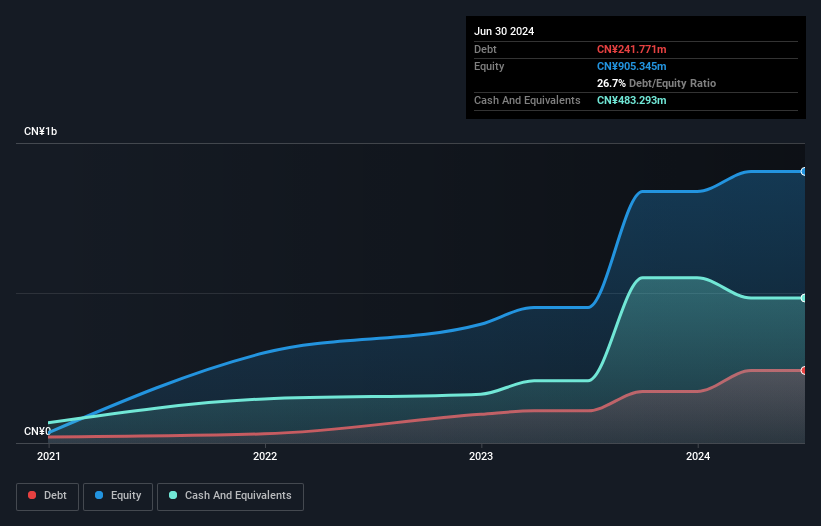David Iben put it well when he said, 'Volatility is not a risk we care about. What we care about is avoiding the permanent loss of capital.' So it might be obvious that you need to consider debt, when you think about how risky any given stock is, because too much debt can sink a company. Importantly, BaTeLab Co., Ltd. (HKG:2149) does carry debt. But is this debt a concern to shareholders?
What Risk Does Debt Bring?
Generally speaking, debt only becomes a real problem when a company can't easily pay it off, either by raising capital or with its own cash flow. Ultimately, if the company can't fulfill its legal obligations to repay debt, shareholders could walk away with nothing. However, a more common (but still painful) scenario is that it has to raise new equity capital at a low price, thus permanently diluting shareholders. Of course, plenty of companies use debt to fund growth, without any negative consequences. The first step when considering a company's debt levels is to consider its cash and debt together.
Check out our latest analysis for BaTeLab
What Is BaTeLab's Net Debt?
You can click the graphic below for the historical numbers, but it shows that as of June 2024 BaTeLab had CN¥241.8m of debt, an increase on CN¥107.4m, over one year. However, it does have CN¥483.3m in cash offsetting this, leading to net cash of CN¥241.5m.

How Healthy Is BaTeLab's Balance Sheet?
The latest balance sheet data shows that BaTeLab had liabilities of CN¥486.4m due within a year, and liabilities of CN¥4.34m falling due after that. Offsetting these obligations, it had cash of CN¥483.3m as well as receivables valued at CN¥131.2m due within 12 months. So it can boast CN¥123.8m more liquid assets than total liabilities.
This surplus suggests that BaTeLab has a conservative balance sheet, and could probably eliminate its debt without much difficulty. Simply put, the fact that BaTeLab has more cash than debt is arguably a good indication that it can manage its debt safely.
Another good sign is that BaTeLab has been able to increase its EBIT by 22% in twelve months, making it easier to pay down debt. When analysing debt levels, the balance sheet is the obvious place to start. But ultimately the future profitability of the business will decide if BaTeLab can strengthen its balance sheet over time. So if you want to see what the professionals think, you might find this free report on analyst profit forecasts to be interesting.
Finally, a business needs free cash flow to pay off debt; accounting profits just don't cut it. While BaTeLab has net cash on its balance sheet, it's still worth taking a look at its ability to convert earnings before interest and tax (EBIT) to free cash flow, to help us understand how quickly it is building (or eroding) that cash balance. Over the last three years, BaTeLab saw substantial negative free cash flow, in total. While investors are no doubt expecting a reversal of that situation in due course, it clearly does mean its use of debt is more risky.
Summing Up
While we empathize with investors who find debt concerning, you should keep in mind that BaTeLab has net cash of CN¥241.5m, as well as more liquid assets than liabilities. And we liked the look of last year's 22% year-on-year EBIT growth. So we are not troubled with BaTeLab's debt use. There's no doubt that we learn most about debt from the balance sheet. But ultimately, every company can contain risks that exist outside of the balance sheet. For instance, we've identified 1 warning sign for BaTeLab that you should be aware of.
If you're interested in investing in businesses that can grow profits without the burden of debt, then check out this free list of growing businesses that have net cash on the balance sheet.
Valuation is complex, but we're here to simplify it.
Discover if BaTeLab might be undervalued or overvalued with our detailed analysis, featuring fair value estimates, potential risks, dividends, insider trades, and its financial condition.
Access Free AnalysisHave feedback on this article? Concerned about the content? Get in touch with us directly. Alternatively, email editorial-team (at) simplywallst.com.
This article by Simply Wall St is general in nature. We provide commentary based on historical data and analyst forecasts only using an unbiased methodology and our articles are not intended to be financial advice. It does not constitute a recommendation to buy or sell any stock, and does not take account of your objectives, or your financial situation. We aim to bring you long-term focused analysis driven by fundamental data. Note that our analysis may not factor in the latest price-sensitive company announcements or qualitative material. Simply Wall St has no position in any stocks mentioned.
About SEHK:2149
BaTeLab
Engages in the research, development, and sale of analog integrated circuit (IC) patterned wafers used in packaging and testing solutions in China.
High growth potential with proven track record.
Market Insights
Community Narratives


Recently Updated Narratives


Alphabet: The Under-appreciated Compounder Hiding in Plain Sight


MINISO's fair value is projected at 26.69 with an anticipated PE ratio shift of 20x


The Quiet Giant That Became AI’s Power Grid
Popular Narratives


The company that turned a verb into a global necessity and basically runs the modern internet, digital ads, smartphones, maps, and AI.


MicroVision will explode future revenue by 380.37% with a vision towards success



